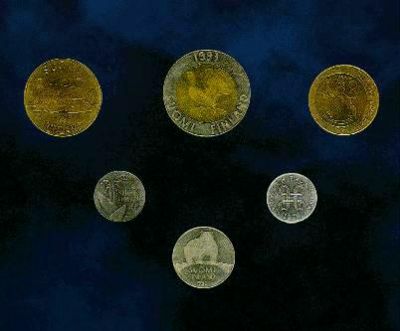芬兰马克
出自 MBA智库百科(https://wiki.mbalib.com/)
芬兰马克(Finnish Markka, FinnishMark),原符号:MK.;FM.; FK.;FMK.,标准符号:FIM
目录 |
芬兰原属瑞典,拿破仑一世与沙皇亚历山大一世缔结蒂尔西特条约(1809年)后划归俄国。1809年,芬兰成为俄罗斯帝国的一个大公园,享有一定的独立。两年后,芬兰中央银行于1811年诞生。1812年,开始发行“戈比”纸币,与瑞典货币同时通行,直到1840年,俄芬卢布才彻底取代瑞典货币。
芬兰于1860年创立了第一个专门货币单位马克。1860年,俄国沙皇尼古拉斯二世下令制造了马克,先以白银、后以黄金(自1877年起)作担保的马克,于l865年终于替代了卢布。经地方当局批准,芬兰银行于1886年获得发行钞票的专利,并于1889年开始发行马克纸币。
之所以取名马克,一个来自日耳曼语而不是斯拉夫语的名字,则是芬兰希望脱离沙皇统治的一种表示。
芬兰马克对黄金的可兑换于1915年停止执行。芬兰于1917年宣布独立。根据宪法第73节的规定,芬兰银行被置于议会任命的“监理会”的监督之下。芬兰于1926年重新接受金本位,于1931年彻底放弃。
芬兰马克流通至2002年2月28日,随后由欧元取代。
芬兰是国际货币基金组织的创始国之一(1948年加入该组织)。芬兰马克于1957年成为可兑换。为顶住通货膨胀的压力,l963年通过货币改革,发行币值等于100旧马克的“新马克”。在放弃布雷顿森林体系后,芬兰马克挂靠一套组合货币(1977年),随后(1991年)又单方面与埃居(欧洲货币单位) 挂靠。
芬兰于1996年接受欧洲货币体系的汇兑机制。
中文全称: 芬兰马克
英文全称:Finnish Markka (or Mark)
标准符号:FIM
纸币面值:10,50,100,500,1000等
铸币面值: 1、5、10、20、50盆尼和1、5马克
币值换算:1马克=100盆尼
2002年3月1日,芬兰本国货币停止流通,芬兰马克一百多年的历史也将随之结束。随着这一天的临近,芬兰人对芬兰马克依依不舍的留恋之情越来越浓。2001年底,芬兰国家博物馆专门举行大规模纪念展,向芬兰马克作最后告别。许多人特地来到芬兰中央银行购买去年发行的芬兰马克现钞及硬币作为收藏。芬兰海运局还专门从芬兰中央银行买下了一批尚未使用过的面值5芬兰马克的硬币。这批1978年铸造的硬币有芬兰乌尔霍破冰船的图案。芬兰海运局认为,它不仅代表着芬兰先进的造船业,更代表着芬兰的航海业,值得收藏,同时可作为馈赠的礼品。
芬兰古城波尔沃的市政府代表伊尔卡·阿拉瓦在2001年12月21日向市政府提出一项建议:在该市为芬兰马克竖立一座纪念碑,其理由是,芬兰马克值得纪念!波尔沃作为芬兰的古城是建立芬兰马克纪念碑的理想地点。纪念碑的碑文为:“芬兰马克的历史(1860—2002)”。
The History of the Finnish Markka (1860 – 2002 )
Prehistory
The oldest coins found in Finland are about 2000 years old. In museums there are some Roman copper coins from that period. Silver coins became common in the ninth century. Coins were brought to Finland when trading furs. The Finnish word ‘raha’ (money) has its origin in the word ‘fur’.
The period of Swedish money
In the 13th and 14th centuries there was a mint working in Turku where Swedish kings stroke coins.
During the reign of King Gustav Vasa the öre, the mark and the thjaler were issued in the kingdom of Sweden-Finland.
The period of Russian reign
When Russia had conquered Finland the rouble was declared the official currency in the grand duchy in 1809. The Bank of Finland was established in 1811 and some thirty years later Swedish money was withdrawn from circulation and the Russian silver rouble became the only legal tender.
Senator J.V. Snellman and other pro-Finnish statesmen fed the rulers in St. Petersburg with the ideas that the rouble was too big a unit for a small country like Finland. After years of shilly-shallying Finland obtained its own monetary unit, the markka, (the mark) in 1860. Its value was a quarter of the rouble. The mark got its name according to a monetary unit which was well-known in northern Europe. In the kingdom of Sweden-Finland the mark was used until 1776.
In the beginning of the 1860’s Finland was the only country where the mark was used. Germany took the name of the mark for its money ten years later.
In 1865 silver money became the sole legal tender and the mark was linked to silver replacing the rouble as a means of payment. Thirteen years later the mark was begged to gold.
In 1886 The Bank of Finland was granted the sole right to issue banknotes in Finland. Design of the first banknotes to be manufactured at the bank’s own printing works commenced in the same year and the notes were in circulation three years later.
In 1915 the Bank of Finland suspended the redemption of banknotes in gold.
After Finland’s independence ( 6 December 1917 )
In 1926 Finland returned to the gold standard and five years later it was effectively abandoned.
In 1948 Finland joins in the International Monetary Fund (IMF) and the World Bank (IBRD); the international par value of the mark was defined (officially in 1951 ) in terms of gold and the US dollar In the late 1950’s the mark became an externally convertible currency again.
In 1963 the currency reform was carried out: 1 new mark = 100 old marks.
In the beginning of 1970 the fixed value of the mark in terms of gold is abandoned as the basis for exchange rates and the Bank of Finland started to steer the external value of the mark making use of a currency-basket index. At the end of the year 1986 new 10 and 500 mark banknotes were put into circulation and in 1991 the external value of the mark was defined in relation to the ECU, the currency unit of the European Community.
In 1992 the mark was put to float and a year later new one, five, and ten mark coins were issued as well as 20 mark banknotes. In 1995 Finland became a member of the European Union and also joined the Economic and Monetary Union, EMU and a year later joined the Exchange Rate Mechanism (ERM). In 1999 the EURO was launched as an account currency and three years later new EURO coins and banknotes were issued and the markka became history.


























